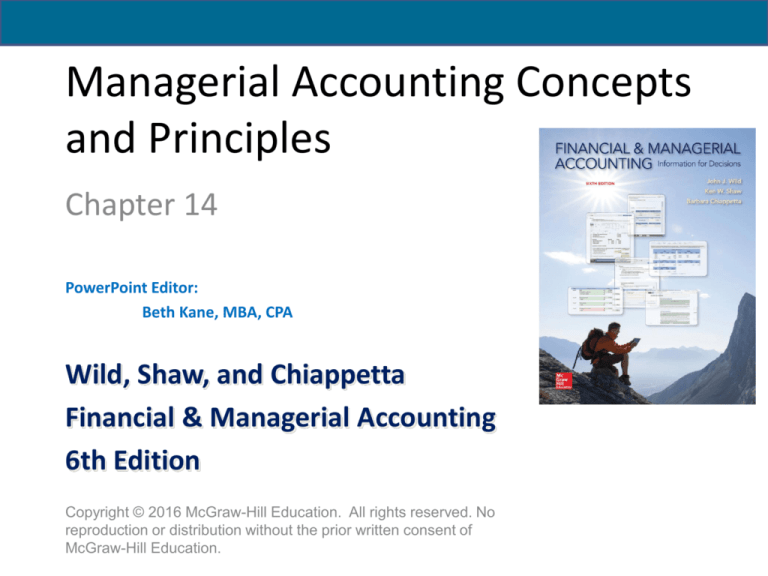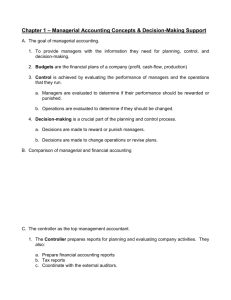
Managerial Accounting Concepts
and Principles
Chapter 14
PowerPoint Editor:
Beth Kane, MBA, CPA
Wild, Shaw, and Chiappetta
Financial & Managerial Accounting
6th Edition
Copyright © 2016 McGraw-Hill Education. All rights reserved. No
reproduction or distribution without the prior written consent of
McGraw-Hill Education.
14-C1: Purpose of Managerial
Accounting
2
18 - 3
Managerial Accounting Basics
Managerial accounting
provides financial and
nonfinancial information
for managers of an
organization and other
decision makers.
C1
3
18 - 4
Purpose of Managerial Accounting
C1
4
18 - 5
Nature of Managerial Accounting
C1
5
18 - 6
Fraud and Ethics in
Managerial Accounting
Fraud affects all business and it is costly: A 2014 Report to
the Nation from the Association of Certified Fraud
Examiners (ACFE) estimates the average U.S. business
loses 5% of its annual revenues to fraud.
The Institute of Management Accountants has issued a code of
ethics to help accountants involved in solving ethical dilemmas.
C1
6
14-C2: Cost Classifications
7
18 - 8
Types of Cost Classifications
Classification by Behavior
Cost
Cost behavior refers to how a
cost will react to changes in
the level of business activity.
• Total fixed costs do
not change when activity
changes.
Cost
Activity
Activity
C2
• Total variable costs change
in proportion
to activity changes.
8
18 - 9
Types of Cost Classifications
Classification by Traceability
Direct costs
Costs traceable to a
single cost object.
Examples: material
and labor cost for a
product.
C2
Indirect costs
Costs that cannot
be traced to a
single cost object.
Example: A
maintenance
expenditure
benefiting two or
more departments.
9
14-C3: Comparing Product
and Period Costs
10
18 - 11
Types of Cost Classifications
Classification by Function
Direct
Labor
Direct
Material
Manufacturing
Overhead
Product
Period costs are expenses not attached to the product.
Selling costs are incurred to
obtain orders and to deliver
finished goods to customers.
C3
Administrative costs are
non-manufacturing costs
of staff support and
administrative functions.
11
18 - 12
Period and Product Costs
in Financial Statements
C3
12
18 - 13
Identifications of
Cost Classifications
C3
13
18 - 14
Cost Concepts for
Service Companies
The cost concepts described are generally
applicable to service organizations.
For example, the cost of
beverages for
passengers of Southwest
Airlines is a variable cost
based on number of
passengers.
C3
14
NEED-TO-KNOW
Following are the costs of a company that manufactures computer chips. Classify each as either a product
cost or a period cost. Then classify each of the product costs as direct material, direct labor, or factory
overhead.
1. Plastic board used to mount the chip
2. Advertising costs
3. Factory maintenance workers’ salaries
4. Real estate taxes paid on the sales office
1. Plastic board used to mount the chip
2. Advertising costs
3. Factory maintenance workers’ salaries
4. Real estate taxes paid on the sales office
5. Real estate taxes paid on the factory
6. Factory supervisor salary
7. Depreciation on factory equipment
8. Assembly worker hourly pay to make chips
Product Costs
All Factory Costs
Assets on Balance Sheet
C2/C 3
5. Real estate taxes paid on the factory
6. Factory supervisor salary
7. Depreciation on factory equipment
8. Assembly worker hourly pay to make chips
Product Costs
Direct
Direct
Factory
Material Labor Overhead
X
Period
Cost
X
X
X
X
X
X
X
Period Costs
Non-Factory Costs
Expensed on Income Statement as
Selling, General and Administrative
15
18 - 16
Manufacturer’s Costs
C3
16
18 - 17
Direct Materials
Direct material costs are the expenditures for
direct materials that are separately and
readily traced through the manufacturing
process to finished goods.
Example:
Steel used in the
frame of a
mountain bike.
C3
17
18 - 18
Direct Labor
Direct labor costs are the wages and salaries for
direct labor that are separately and readily
traced through the manufacturing process to
finished goods.
Example:
Wages paid to a
mountain bike
assembly worker.
C3
18
18 - 19
Factory Overhead
Factory overhead consists of all manufacturing
costs that are not direct materials or direct labor
and the costs cannot be separately or readily
traced to finished goods.
Examples:
Indirect labor – maintenance.
Indirect material – cleaning supplies.
Factory utility costs.
Supervisory costs.
C3
19
18 - 20
Prime and Conversion Costs
Manufacturing costs are often
combined as follows:
Direct
Material
Direct
Labor
Prime
Cost
C3
Manufacturing
Overhead
Conversion
Cost
20
14-C4: Balance Sheet
21
18 - 22
Reporting Manufacturing Activities
Merchandisers . . .
Manufacturers . . .
Buy
finished goods.
Buy
raw materials.
Sell
finished goods.
Produce
and sell
finished goods.
SaleMart
C4
22
18 - 23
Manufacturer’s Balance Sheet
MERCHANDISER
Current Assets
Cash
Receivables
Merchandise
Inventory
MANUFACTURER
Current Assets
Cash
Receivables
Inventories
Raw Materials
Goods in Process
Finished Goods
The primary difference is inventory.
C4
23
18 - 24
Manufacturer’s Balance Sheet
Raw
Materials
Goods in
Process
Finished
Goods
Materials
waiting to be
processed.
Partially complete
products.
Completed
products
for sale.
Can be direct
or indirect.
Material to which
some labor and/or
overhead have
been added.
C4
24
14-P1: Income Statement
25
18 - 26
Manufacturer’s Income Statement
P1
26
18 - 27
Cost of Goods Sold for a
Merchandiser and Manufacturer
Cost of goods sold for
manufacturers differs
only slightly from cost of
goods sold for
merchandisers.
P1
27
NEED-TO-KNOW
Indicate whether the following financial statement items apply to a manufacturer, a merchandiser, or a
service provider. Some items apply to more than one type of organization.
1. Merchandise inventory
2. Finished goods inventory
3. Cost of goods sold
Manufacturer
4. Operating expenses
5. Cost of goods manufactured
6. Supplies inventory
Merchandiser
Produces units for sale
Purchases units for resale
Balance Sheet includes:
Raw Materials Inventory
Work in Process Inventory
Finished Goods Inventory
Balance Sheet includes:
Merchandise Inventory
Manufacturer
1. Merchandise inventory
2. Finished goods inventory
3. Cost of goods sold
4. Operating expenses
5. Cost of goods manufactured
6. Supplies inventory
P1
X
X
X
X
X
Service Provider
Does not provide a product to its
customers; no inventories.
Merchandiser
X
Service Provider
X
X
X
X
X
28
14-C5: Flow of Manufacturing
Activities
29
18 - 30
Activities and Cost Flows
in Manufacturing
C5
30
14-P2: Schedule of Cost of
Goods Manufactured
31
18 - 32
Schedule of Cost of Good
Manufactured
Summarizes the types and amounts of costs
incurred in a company’s manufacturing process.
P2
+
+
=
+
–
=
Direct Materials Used
Direct Labor
Factory Overhead
Total Manufacturing Costs
Beginning Work in Process
Ending Work in Process
Cost of Goods Manufactured
32
18 - 33
Manufacturing Statement
P2
33
18 - 34
Manufacturing Statement
P2
34
18 - 35
Manufacturing Statement
Include all direct labor costs
incurred during the current period.
P2
35
18 - 36
Manufacturing Statement
P2
36
18 - 37
Manufacturing Statement
P2
37
18 - 38
Overhead Cost Flows Across
Accounting Reports
P2
38
NEED-TO-KNOW
Compute the following three measures using the information below.
1. Cost of materials used
$70,900 Cost of Direct Materials transferred from Raw Materials Inventory to Work in
Process Inventory.
2. Cost of goods manufactured
$173,900 Cost of goods completed in the current period and transferred from Work in
Process Inventory to Finished Goods Inventory.
3. Cost of goods sold
$160,500 Cost of goods leaving Finished Goods Inventory and going to the customer.
Expensed on the income statement.
Beginning raw materials inventory
Beginning work in process inventory
Beginning finished goods inventory
Raw materials purchased
Total factory overhead used
Raw Materials Inventory
Beg. Inv.
Purchases
15,500
66,000
Avail for Use
81,500
P1/P 2
10,600
Ending raw materials inventory
$10,600
Ending work in process inventory 44,000
Ending finished goods inventory
37,400
Direct labor used
38,000
Work in Process Inventory
Beg. Inv.
Matls. Used
Direct Labor
Fact. OH
Avail for Mfg.
Matls. Used
End. Inv.
$15,500
29,000
24,000
66,000
80,000
29,000
70,900
38,000
80,000
217,900
70,900
44,000
24,000
173,900
Avail for Sale 197,900
Cost of GM
End. Inv.
Finished Goods Inventory
Beg. Inv.
Cost of GM
173,900
Cost of GS
End. Inv.
160,500
37,400
39
NEED-TO-KNOW
Raw Materials Inventory
Beg. Inv.
Purchases
15,500
66,000
Avail for Use
81,500
Matls. Used
End. Inv.
10,600
Work in Process Inventory
Beg. Inv.
Matls. Used
Direct Labor
Fact. OH
Avail for Mfg.
70,900
44,000
Balance Sheet
Current assets:
Raw Materials Inventory
Work in Process Inventory
Finished Goods Inventory
Income Statement
Sales
Cost of Goods Sold
P1/P 2
Beg. Inv.
Cost of GM
24,000
173,900
Avail for Sale 197,900
Cost of GM
End. Inv.
Finished Goods Inventory
29,000
70,900
38,000
80,000
217,900
173,900
Cost of GS
End. Inv.
160,500
37,400
$10,600
44,000
37,400
$XXXXX
(160,500)
40
14-C6: Trends in Managerial
Accounting
41
18 - 42
Trends in Managerial Accounting
Customer
Orientation
E-Commerce
Lean Practices
C6
Global
Economy
Service
Economy
Value Chain
42
18 - 43
Customer Orientation
C6
43
18 - 44
Total Quality Management
Quality improvement
applied to all aspects of
business activities.
Seek and uncover
waste.
Constant Focus on
Higher Standards
Employees encouraged
to try new methods
to improve quality.
C6
Company emphasizes
value of quality through
quality awards.
44
18 - 45
Just-In-Time (JIT) Manufacturing
Receive
customer
orders
Complete products
just-in-time to
ship to customers
Schedule
Production
Receive materials
just-in-time for
production
C6
Complete parts
just-in-time for
assembly into products
45
18 - 46
Value Chain
The value chain refers to the series of activities that
add value to a company’s products or services.
Companies can use lean practices to increase
efficiency and profits.
C6
46
Global View
47
14-A1: Raw Materials
Inventory Turnover and Days’
Sales
48
18 - 49
Raw Materials Inventory Turnover
Raw materials
Inventory turnover =
A1
Raw materials used
Average materials
inventory
49
18 - 50
End of Chapter 14
50





